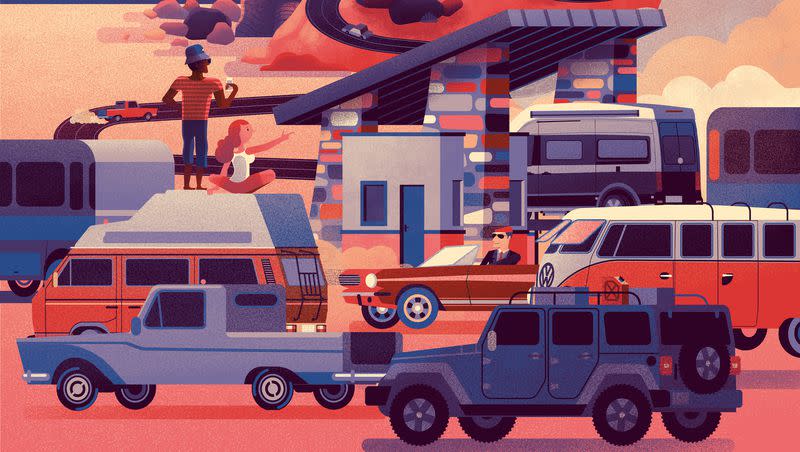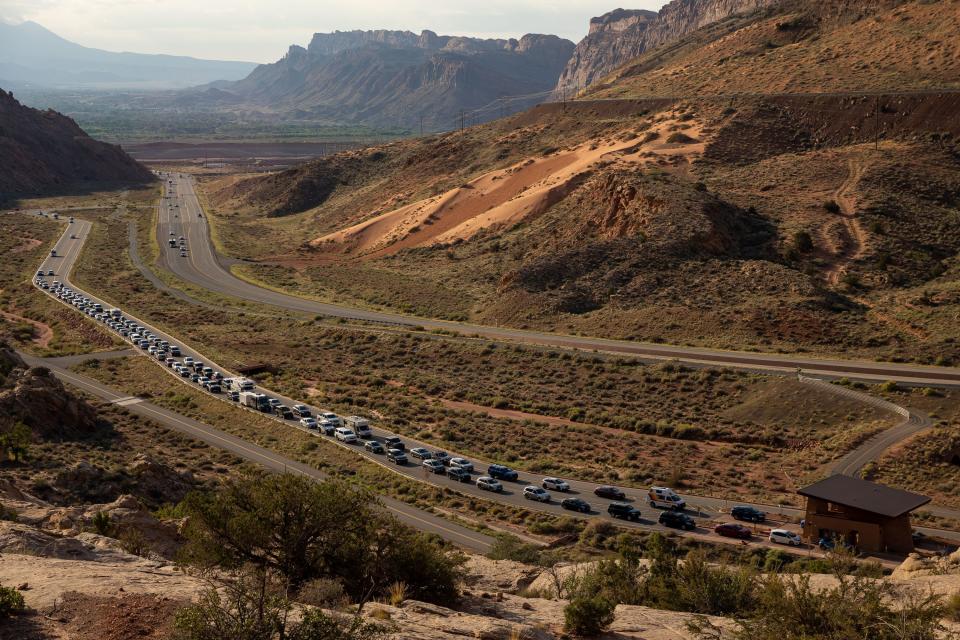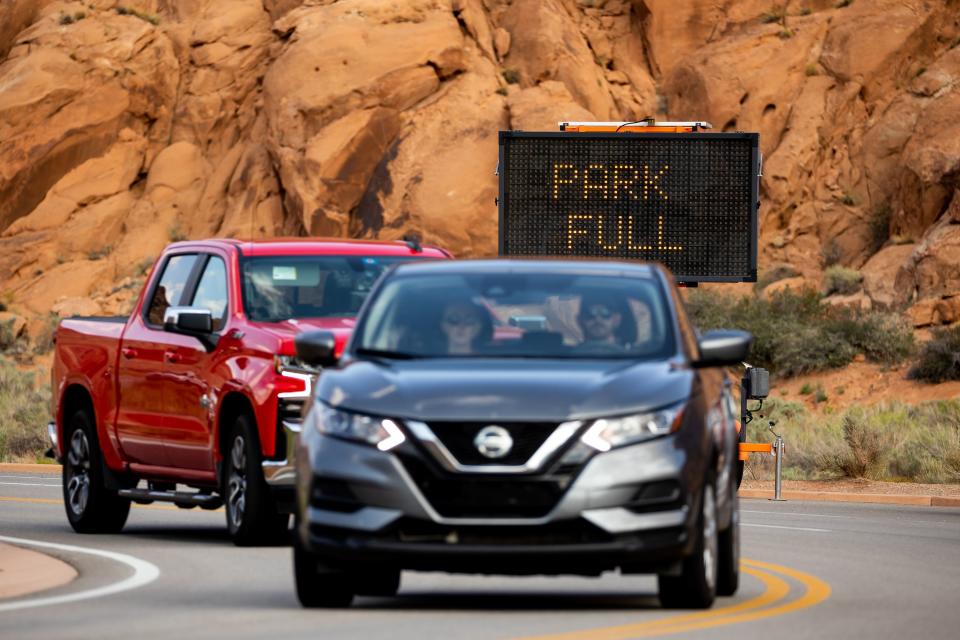The tipping point of national parks

Evan Clapper says he could literally feel the increasing number of visitors to the area eroding the landscape. “Our sandstone is fairly brittle, so climbing holds wear away,” the Grand County commissioner and multisport guide from Moab, Utah, says. “What were once crisp sharp edges in the rock have become rounded slopers from so many people using them.”
It’s not just the climbing areas that are seeing the signs of overuse. Noise pollution has increased in town, trails are more crowded, fragile ecosystems have been trampled. At the gate to enter Arches National Park north of town, Park Service public affairs specialist Kaitlyn Thomas says the line could stretch for hours in the hot desert sun, and every trailhead was packed. Bathroom breaks in the line became a public nuisance and visitors who were turned back threw hissy fits at the gate. “The staff has to process more visitors through the gate, and it was hard on those visitors,” she says. Plus, “folks who offer guided tours or other services in the parks couldn’t predict when they’d have access.”
Related
The number of visitors to the Moab area has more than doubled in the last decade, according to Madeline Logowitz, director of the Grand County Trails Division. Arches National Park sees nearly 2 million visitors annually now, thanks to a combination of marketing campaigns, the pandemic and the rise of social media. “Because the internet exists, now people have popularized going to places where there isn’t infrastructure. We’re seeing more impact and more diffusion in new places,” Logowitz says.
“We don’t want to create industrial tourism. A lot of it has to do with protecting the feeling of community, and a sense of place and belonging.”
The visitorship is good in a lot of ways. In tourism-dependent towns like Moab, recreational visitors keep the economic engine chugging along. According to the Kem C. Gardner Policy Institute, the two-year change in tourism-related taxable sales has jumped over 51 percent from pre-pandemic years in Grand County, with $400 million more coming into the state from Utah’s national parks as a result. But Moab, and the landscape around it, is hitting its limits.
How does the government preserve national parks?
Recently, land managers, government officials and local businesses started making changes to rein in the negative impacts of land use and to try to answer the question: How do you ensure everyone can get time on public lands in a way that’s not destructive for the park and for the community? Logowitz says that some consequences of increased visitation include a surge in search and rescue calls. “At one point they were the most active search and rescue in the state,” she says. There’s also vandalism to archaeological sites, increased trash, human waste, trail widening and a growing number of conflicts between users, especially between motorized users and hikers or bikers.

The trails program decided that the best thing to do was to educate visitors about how to lighten their impact. In fall 2021, they piloted a responsible recreation program, staging employees at trailheads to talk to hikers, bikers and motorized users about how and where they should travel. It was so successful that last year it was formalized into a full-time program. Seven ambassadors have talked to 55,000 people on the trails around Moab. “We have talking points about how to protect themselves and the environment, and to respect other users,” Logowitz says. “But we also make sure they’re talking about issues specific to place. At a place where there’s a lot of cliff jumping, we talk about broken ankles.”
Are national parks too busy?
Even if everyone who steps foot on public lands is educated about their impact, increased crowding still changes their experience. As traffic ramped up at Arches, the Park Service management decided it needed a way to control crowds. So, last summer, Arches initiated a timed entry pilot program, where visitors had to make reservations ahead of time, and were given a time slot when they could visit the park.
Related
Arches’ timed entry plan was initially proposed in 2017, as crowds started to ramp up even before Covid. But local businesses in the Moab area worried that it would impact their bottom lines, especially because a 2018 report from the National Park Service found that the program could cost tourism $22 million in its first year, in large part because of how it would impact tour buses and big groups. Hundreds of travel businesses signed a letter in July 2022 asking Chuck Sams, the director of the National Park Service, to stop the program, because they worried it would deter visitors, especially international ones.
So the park leadership got together with the county commissioners and the Chamber of Commerce and tried to see how they could tweak the plan for everyone. “There were a lot of ideas they thought of that we hadn’t,” Thomas says. For instance, officials were thinking of doing timed entry from 6 a.m. to 7 p.m. and local restaurants proposed a shift to drive business back into Moab for dinner.
“We’re this rural small town— it’s not Disneyland or Vegas. And it’s a fragile place.”
What is sustainable tourism?
Clapper says sustainable tourism is a matter of balancing open access with choices that support the community and the landscape. Tourism will dry up if the experience — and the ecosystem — aren’t protected, so policies and practices that bring people in, support the local workers and respect the land are crucial. “We don’t want to create industrial tourism,” he says. “A lot of it has to do with protecting the feeling of community, and a sense of place and belonging.”
Even when existing red tape pushes for increases in tourism, there are ways to create balance within the demands. Currently, Moab collects a tourism tax on hotels and restaurants, but part of the existing law dictates that the lion’s share of that tax must be spent on promotions. And right now, that promotion outpaces the mitigation of human impact. So the county passed an ordinance that any promotion has to include an educational or sustainability component. Now, all ads and marketing materials have to include “Leave No Trace” education material.
At Arches, management is turning to data to figure out the best ways to control impact. Officials had a social science intern in the park all last summer to track when they were turning people away and how they could best ensure that the most people had good experiences. They found that they were turning away about nine percent of people who came to the entry gate because they didn’t have reservations. Most of those people were able to come the next day. They gauged line length and parking lot crowding to figure out when they could have flexibility. Going into the current season, the park has adjusted the number of reservations that could be made the day before. “I know that a lot of the businesses became really well-versed in timed entry; hotels ended up helping people make reservations,” Thomas says.
Communication between businesses, land managers and policymakers is crucial because they can decide what they want their community to be like, and then share it with visitors. They can come up with a plan to protect the landscape, the needs of their workers and their town, and the desires of the visitors their economy depends on. “We’re this rural small town, it’s not Disneyland or Vegas. And it’s a fragile place,” Clapper says. “We want people to treat it with respect not just as a place now, but as a place you can save for your kids and grandkids when they want to come.”
This story appears in the June issue of Deseret Magazine. Learn more about how to subscribe.


